The 2017 Hyundai Elantra marked a significant step forward for the compact sedan, injecting fresh style, enhanced safety features, and improved efficiency into a segment already brimming with competition. Arriving at dealerships in January 2016, this iteration of the Hyundai Elantra 2017 aimed to solidify its position as a value leader, building upon its reputation for offering more for less. Priced competitively, starting at $17,150 – even less than the outgoing model – the new Elantra packed a punch with two new engine options focused on fuel economy, a smoother ride, and a quieter cabin experience. Let’s delve into what made the Hyundai Elantra 2017 a compelling choice for car buyers.
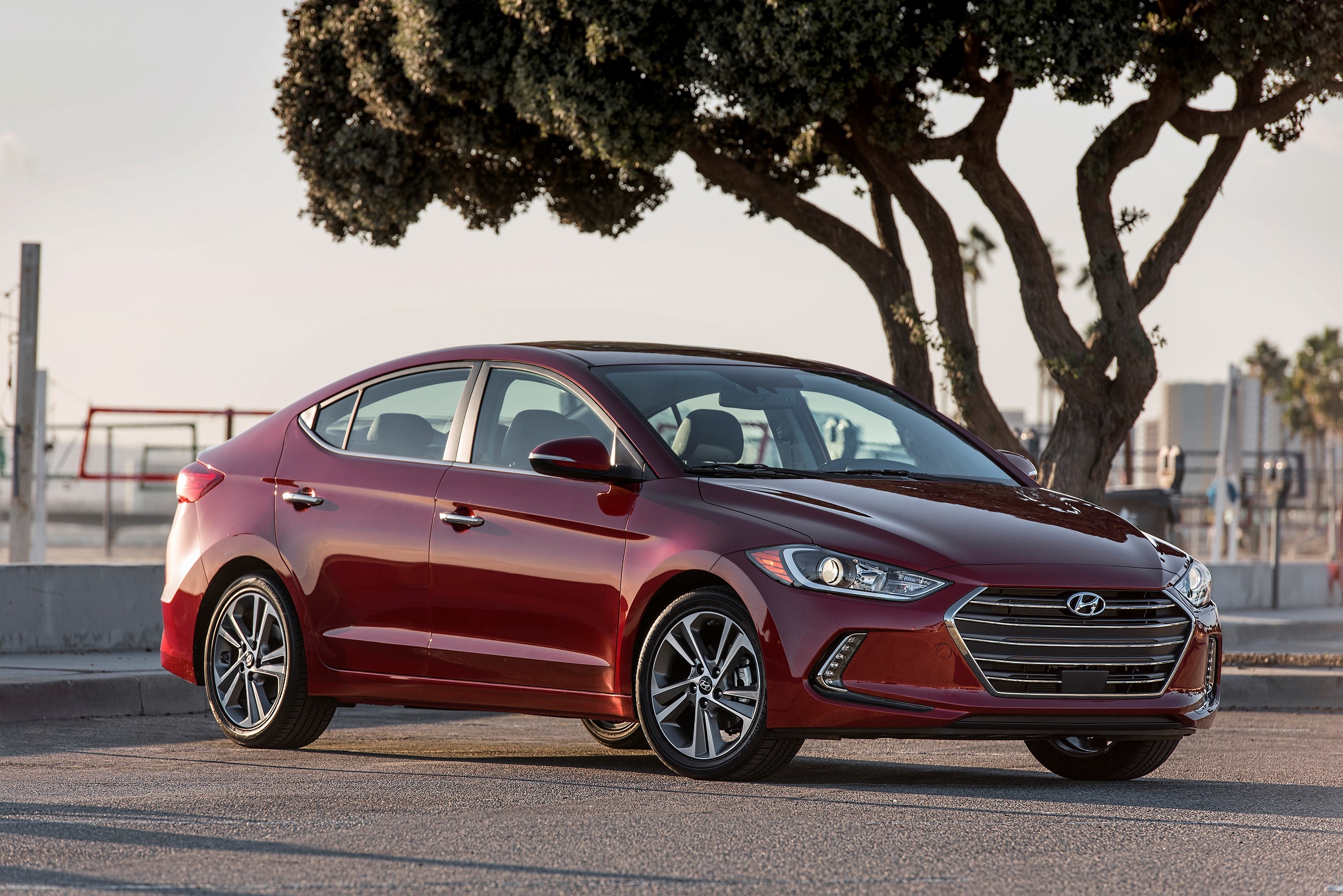 Front view of a 2017 Hyundai Elantra Sedan in silver, showcasing its hexagonal grille and modern headlight design.
Front view of a 2017 Hyundai Elantra Sedan in silver, showcasing its hexagonal grille and modern headlight design.
Sculpted Design and Aerodynamic Efficiency
The exterior of the Hyundai Elantra 2017 exudes confidence with its sculpted body and flowing lines. Hyundai’s design philosophy of “dynamic precision” is evident in the car’s architecture, a collaborative effort between designers and engineers to merge striking aesthetics with functional aerodynamics.
The front fascia is dominated by Hyundai’s signature hexagonal grille, giving the Elantra a recognizable and assertive face. This is further enhanced by modern lighting elements, including available HID headlights with Dynamic Bending Lights – a feature that adjusts the headlight direction with steering input for improved visibility in corners. Unique vertical LED daytime running lights add a touch of sophistication and are a first for the Elantra model. The sporty lower front fascia isn’t just for looks; it incorporates functional front wheel air curtains, borrowed from the Sonata Hybrid, to optimize airflow around the front wheels, reducing turbulence and drag. These aerodynamic enhancements extend to the underbody covers, rear bumper spoiler, and the rear decklid, all contributing to an impressive 0.27 coefficient of drag.
Running along the side, a sleek character line emphasizes the sweeping side window silhouette and striking profile. Available premium touches like 17-inch alloy wheels, new LED door handle approach lights, side mirror LED turn signal indicators, and LED taillights with high-tech graphics elevate the Hyundai Elantra 2017 beyond the typical compact sedan class, adding a layer of refinement and detail. The car was offered in eight exterior colors, with five being new to the Elantra palette. Dimensionally, the Hyundai Elantra 2017 grew slightly, with an increase in overall length and width, giving it a more planted and athletic stance on the road.
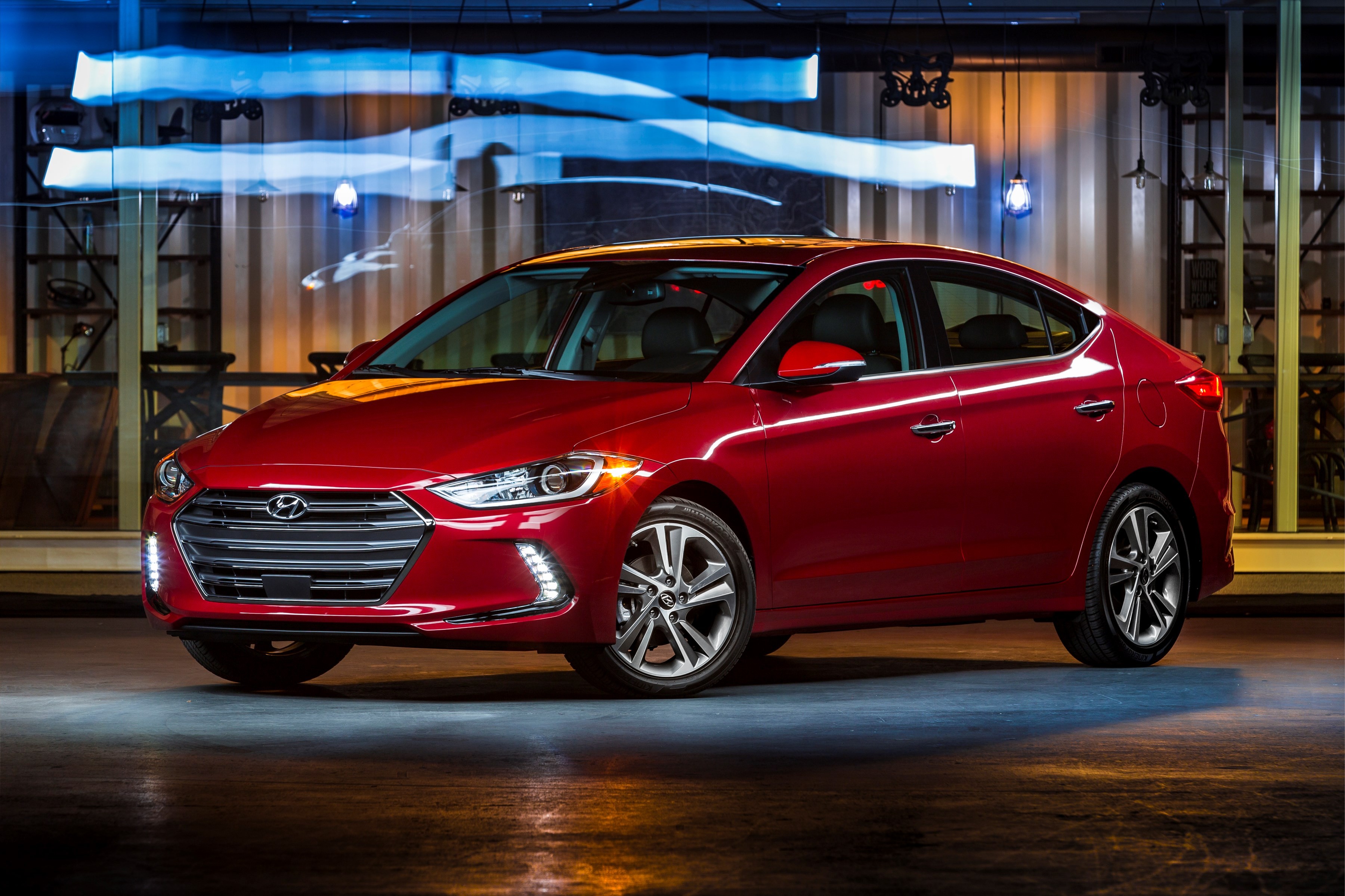 Side profile of a 2017 Hyundai Elantra Sedan in silver, highlighting its sleek lines and available alloy wheels.
Side profile of a 2017 Hyundai Elantra Sedan in silver, highlighting its sleek lines and available alloy wheels.
Interior Refinement and Class-Leading Space
Stepping inside the Hyundai Elantra 2017, you’re greeted by a modern, driver-centric interior designed for intuitive operation and enhanced comfort. The cabin prioritizes high-quality materials and user-friendly technology, creating a welcoming and comfortable environment for both driver and passengers. Soft-touch materials are strategically placed in key touch areas, and high-tech accents contribute to a premium feel.
The instrument panel’s wide design enhances the sense of spaciousness. An available 4.2-inch color TFT LCD instrument display improves driver visibility and provides essential vehicle information at a glance. The center stack is horizontally oriented, with controls logically grouped by function and subtly angled towards the driver for optimal ergonomics. Premium convenience features, often unexpected in this segment, include an integrated memory system for the power driver’s seat and side mirrors – a segment first – along with dual automatic temperature control with an auto-defogging system and an auto-dimming rearview mirror. Ergonomic front seats, constructed with high-tension lightweight frames for improved collision performance and multi-firmness seat pads to reduce fatigue on long drives, further enhance comfort.
All seats in the Hyundai Elantra 2017, whether cloth or available leather, utilize SoyFoam™, an eco-conscious seating foam that replaces petroleum-based polyol with soybean oil, optimizing both comfort and environmental considerations. Available heated front and rear seats and a versatile 60/40 split-folding rear seat add to passenger convenience and flexibility. The Hyundai Elantra 2017 boasts class-leading interior volume, even being classified as a Midsize car by the EPA with 110.2 cubic feet of total interior volume, outclassing competitors like the Mazda3 and Ford Focus, and even rivaling some premium models in terms of space.
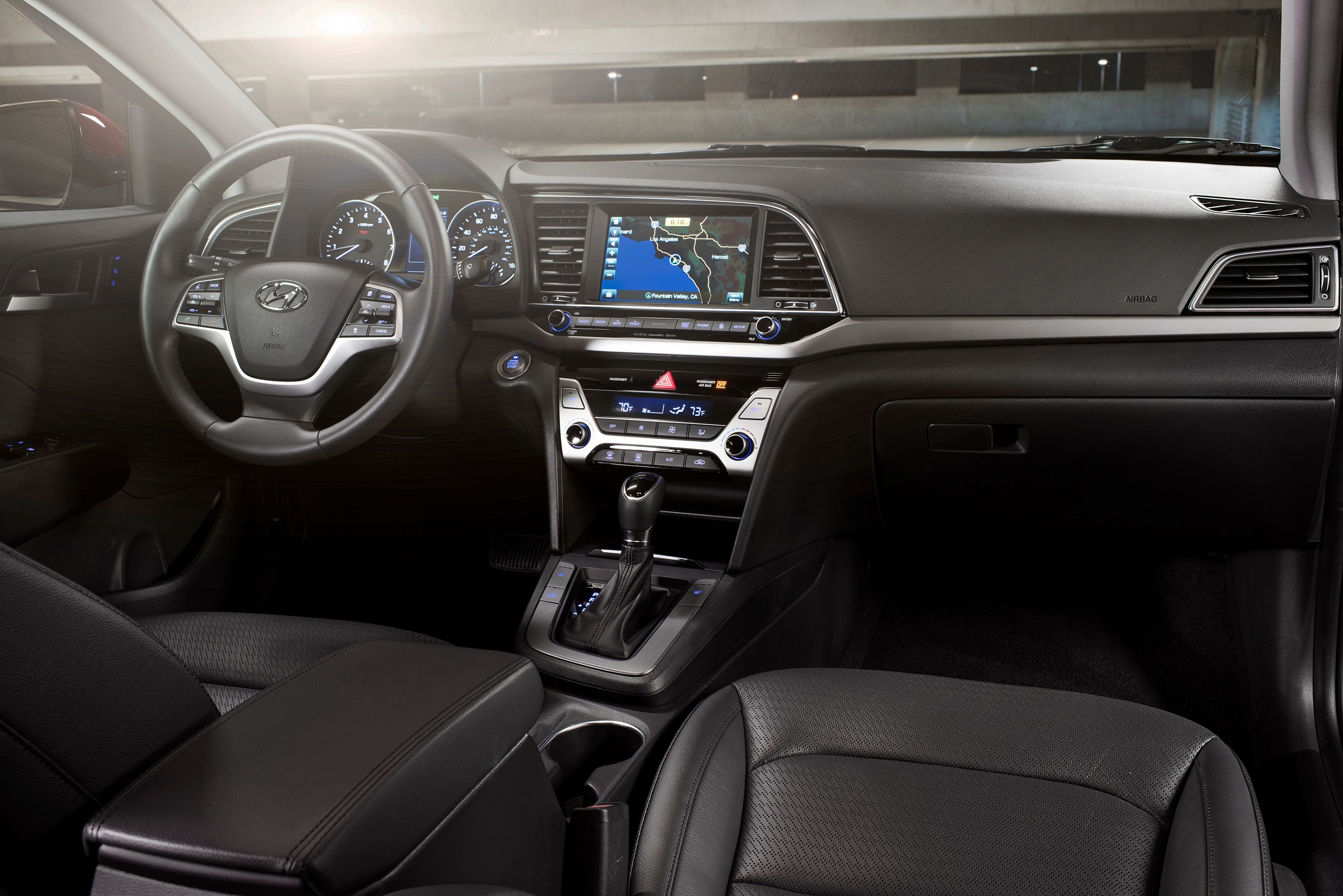 Interior view of a 2017 Hyundai Elantra Sedan showcasing the dashboard, infotainment screen, and spacious cabin design.
Interior view of a 2017 Hyundai Elantra Sedan showcasing the dashboard, infotainment screen, and spacious cabin design.
Hyundai engineers also focused heavily on noise, vibration, and harshness (NVH) reduction for the Hyundai Elantra 2017. A hood insulator is standard on most models to dampen engine noise. The size of the aperture in the front dash panel was reduced by 25%, front door window glass thickness was increased, and sound-absorbing materials were added throughout the pillars, inner fenders, and floorpan. Plastic and rubber bushings were applied to the front sub-frame, and the lower control arm bushing size was increased to further minimize road noise and vibrations.
Chassis and Powertrain Enhancements
The Hyundai Elantra 2017 is built on a lighter yet more rigid chassis, thanks to a significant increase in the use of advanced high-strength steel – now 53% compared to 21% in the previous model. This enhanced steel usage results in a 29.5% increase in torsional rigidity and a 25.3% increase in bending strength, contributing to improved ride and handling, reduced cabin noise, enhanced durability, and better overall driving dynamics. Structural adhesives, often used in aerospace applications, were applied 40 times more extensively at high-stress points to further reinforce the chassis, improving NVH and vehicle dynamics. These structural improvements were a key focus for Hyundai to achieve top safety ratings from both the IIHS and NHTSA.
Ride comfort, handling, and stability were further refined through a redesigned rear suspension geometry. The angle of the rear shock absorbers was modified, and the position of the coil springs on the coupled torsion beam axle was changed. Larger rear bushing diameters enhance long-term durability. The front suspension utilizes a McPherson strut design with coil springs, gas shock absorbers, and a stabilizer bar to minimize body roll during cornering. The standard Motor-Driven Power Steering (MDPS) system provides responsive steering feel and adjusts to varying driving conditions while improving fuel efficiency. Increased caster enhances steering feedback at highway speeds.
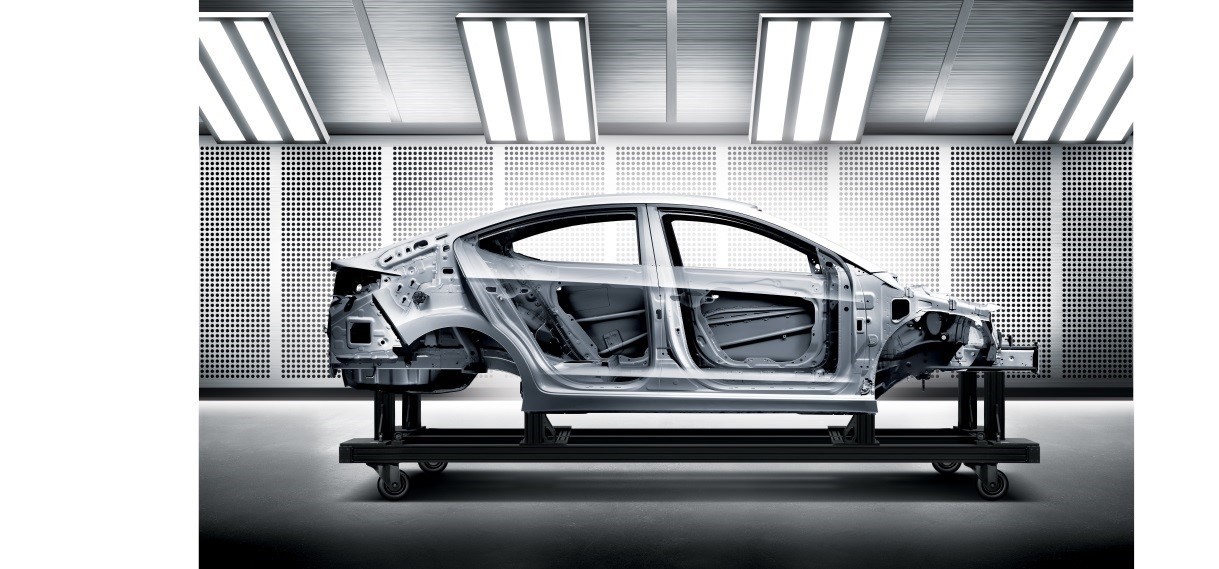 Angled shot of a 2017 Hyundai Elantra in motion, emphasizing its sporty stance and alloy wheels.
Angled shot of a 2017 Hyundai Elantra in motion, emphasizing its sporty stance and alloy wheels.
Under the hood, the Hyundai Elantra 2017 offered two new powertrains designed for improved fuel efficiency and everyday driving performance. The standard engine for SE and Limited trims is a 2.0-liter Nu MPI Atkinson four-cylinder engine, producing 147 horsepower and 132 lb-ft of torque. This Atkinson cycle engine, unique in the compact class for its combination with multi-port injection, enhances efficiency by delaying intake valve closure during the compression stroke, maximizing the expansion ratio and extracting more energy from each combustion cycle. Other enhancements include intermediate valve cam phasing, high energy ignition coils, an electronically controlled thermostat, and piston cooling jets, all contributing to a 2.2% increase in efficiency and an EPA fuel economy rating of up to 33 mpg combined for the Elantra SE with the automatic transmission.
This 2.0-liter engine is paired with either a standard six-speed manual transmission (available on the SE trim) or Hyundai’s next-generation six-speed automatic transmission. The new automatic transmission improves efficiency by 3.3% and features a new valve body for quicker gear shifts, optimized oil pump size, a multi-clutch torque converter, and minimized friction through double angular ball bearings.
For even greater fuel efficiency, the Hyundai Elantra 2017 Eco trim features an all-new 1.4-liter Kappa turbocharged GDI four-cylinder engine. This engine delivers 128 horsepower and a robust 156 lb-ft of torque at low RPMs, paired with an EcoShift seven-speed dual-clutch transmission. The Eco trim was projected to achieve an impressive 35 mpg combined rating based on internal testing. The 1.4L turbo engine incorporates features like an integrated cylinder head and exhaust manifold, optimized straight intake port, a single scroll turbocharger with an electric wastegate actuator, and high-pressure fuel injectors, all designed to maximize fuel economy and performance.
All Hyundai Elantra 2017 trims come with Drive Mode Select, allowing drivers to choose between Eco, Normal, and Sport modes, adjusting powertrain performance and steering effort to suit driving preferences.
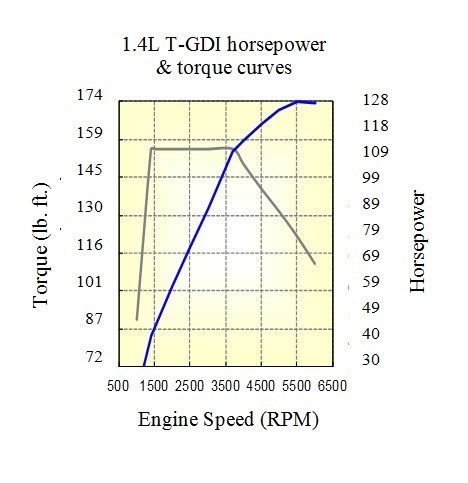 Close-up of the front grille and headlight of a 2017 Hyundai Elantra, highlighting the modern design details.
Close-up of the front grille and headlight of a 2017 Hyundai Elantra, highlighting the modern design details.
Advanced Safety and Driver Assistance Technologies
Safety was a paramount concern in the development of the Hyundai Elantra 2017. Beyond the strengthened chassis, structural improvements were made to the front side members, dash-to-cowl connection, and B-pillar assemblies. The car features seven airbags as standard, including a driver’s knee airbag, along with Electronic Stability Control, Vehicle Stability Management, Traction Control, ABS, and a Tire Pressure Monitoring System. The Hyundai Elantra 2017 was expected to achieve both an IIHS Top Safety Pick+ and a NHTSA 5-star safety rating, reflecting Hyundai’s commitment to occupant protection.
The Hyundai Elantra 2017 also offered a suite of advanced safety technologies, often found in more expensive vehicles. Available Automatic Emergency Braking with class-exclusive Pedestrian Detection uses radar and camera sensors to detect vehicles and pedestrians and can automatically apply emergency braking to prevent or mitigate collisions. Additional available safety features include Lane Departure Warning, Lane Keep Assist System, Blind Spot Detection with Rear Cross-traffic Alert and Lane Change Assist, and a rearview camera with dynamic guidance. Lane Keep Assist uses a forward-facing camera to detect lane markings and provide steering assistance to help prevent unintentional lane departures.
Intelligent Technology and Connectivity
The Hyundai Elantra 2017 brought innovative technology to the compact car class, enhancing both driver confidence and convenience without a premium price tag. A segment-exclusive hands-free Smart Trunk allows for effortless trunk opening by simply approaching the rear of the vehicle with the key fob. Available Dynamic Bending Light (DBL) and Smart Cruise Control (SCC) further elevate the driving experience. DBL enhances nighttime visibility, while SCC maintains a set distance from the vehicle ahead, automatically adjusting speed in varying traffic conditions.
Connectivity and multimedia were also at the forefront. All Hyundai Elantra 2017 models come standard with iPhone®/USB and auxiliary input jacks and SiriusXM® satellite radio. Available infotainment systems include a 7.0-inch Display Audio touchscreen system with a rearview camera and Hyundai’s next-generation 8.0-inch navigation system. Both systems feature Apple® CarPlay and Android® Auto for seamless smartphone integration. A second USB port was also available for charging – a first for Hyundai. The 8.0-inch navigation system boasts an enhanced display with improved touch sensitivity, brighter screen, and a split-screen display. SiriusXM® Satellite Radio and HD Radio® Technology are standard on this system, along with Pandora® capability, SiriusXM® Travel Link®, and “Eyes Free” Siri integration.
For audiophiles, the Hyundai Elantra 2017 offered an available eight-speaker Infinity premium audio system with a center speaker and subwoofer, as well as Harman’s Clari-Fi™ music restoration technology, which enhances the quality of compressed digital audio files.
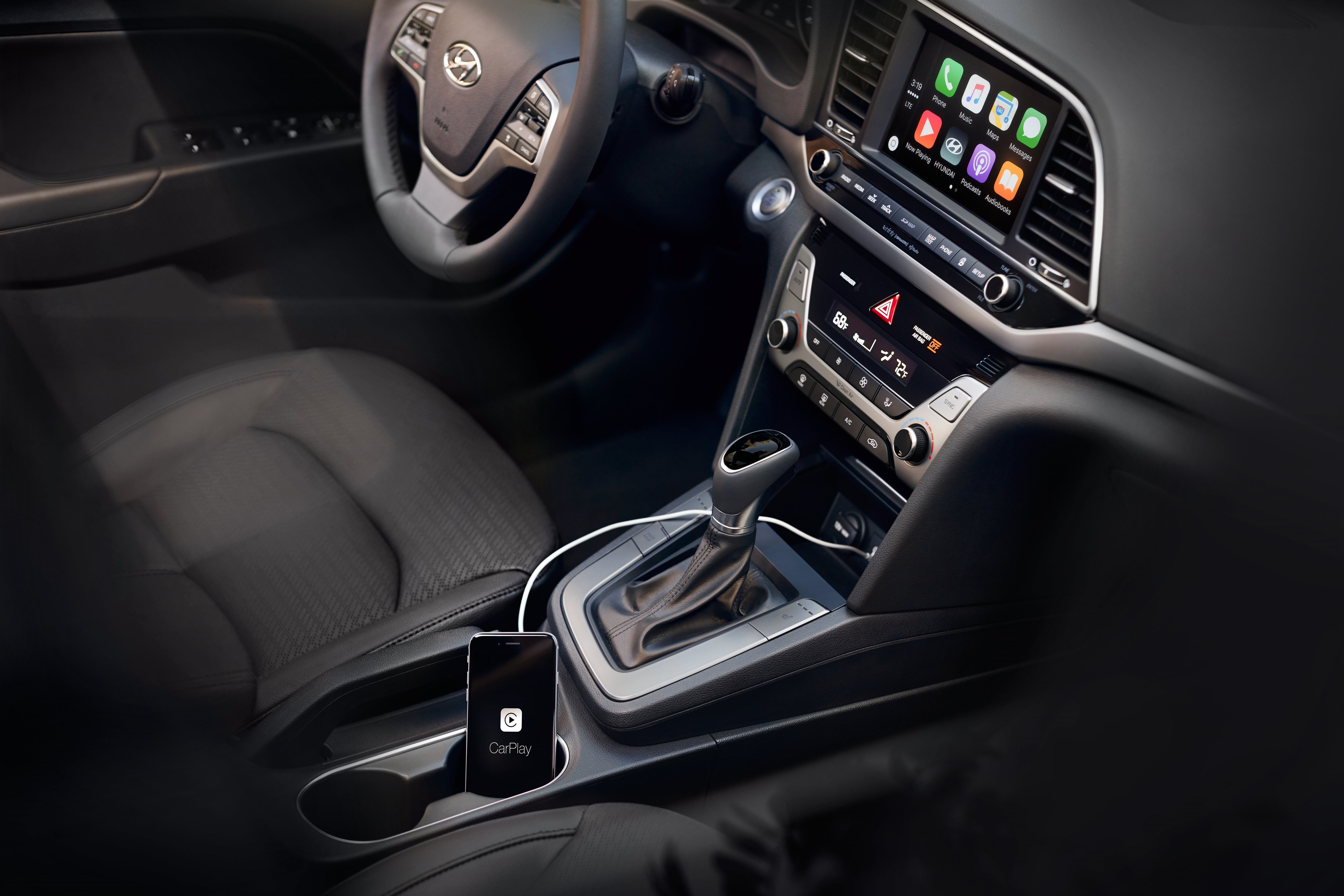 Interior shot of a 2017 Hyundai Elantra showcasing the infotainment system with Apple CarPlay interface.
Interior shot of a 2017 Hyundai Elantra showcasing the infotainment system with Apple CarPlay interface.
Next-Generation Blue Link® Connectivity
The Hyundai Elantra 2017 featured the next-generation Hyundai Blue Link system, providing enhanced safety, service, and infotainment telematics. Blue Link offers features like Remote Start w/ Climate Control, Destination Search powered by Google®, Remote Door Lock/Unlock, Car Finder, Enhanced Roadside Assistance, and Stolen Vehicle Recovery. Blue Link can be accessed via buttons on the rearview mirror, the web, or a smartphone app, and some features are even controllable via Android Wear™ and Apple Watch™ smartwatches. Blue Link was offered in Connected Care & Remote packages (available on all models) and a Guidance package (navigation-equipped models), with a complimentary year of Connected Care for equipped Hyundai Elantra 2017 models.
Conclusion: A Value-Driven Compact Sedan
The Hyundai Elantra 2017 successfully combined stylish design, a spacious and refined interior, enhanced safety features, and efficient powertrains into a compelling package. Its focus on value, offering segment-first features and class-leading space at a competitive price point, made the Hyundai Elantra 2017 a smart choice for buyers seeking a well-rounded and feature-rich compact sedan.